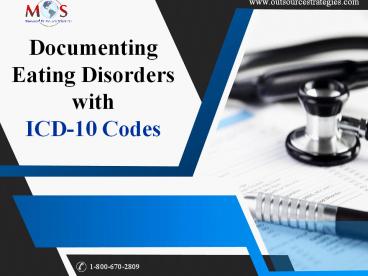Documenting Eating Disorders with ICD-10 Codes - PowerPoint PPT Presentation
Title:
Documenting Eating Disorders with ICD-10 Codes
Description:
For accurate clinical documentation of common eating disorders using ICD-10 diagnosis codes, physicians can benefit from the services of medical billing outsourcing companies. – PowerPoint PPT presentation
Number of Views:49
Title: Documenting Eating Disorders with ICD-10 Codes
1
Documenting Eating Disorders with ICD-10 Codes
2
Eating disorders are psychological disorders
characterized by irregular eating habits and
severe distress or concern about body weight or
shape. The most common eating disorders which can
affect both men and women include Anorexia
nervosa, Bulimia nervosa, Avoidant Restrictive
Food Intake Disorder (ARFID) and Binge-Eating
disorders (BED). Studies say that at least 20
million women and 10 million men in the United
States suffer from an eating disorder at some
point in their life.
3
Warning signs that may indicate an eating
disorder include
Switching between periods of overeating and
fasting
Excessive focus on healthy eating
Obsession with calories and fat contents of food
Chronic dieting
Constant weight fluctuations
Adopting an overly restrictive vegetarian diet
Excessive exercise
4
ICD-10-CM Codes for Common Eating Disorders
1
Anorexia Nervosa
F50 Eating disorders
F50 Eating disorders
F50.0 Anorexia nervosa
F50.00 Anorexia nervosa, unspecified
F50.01 Anorexia nervosa, restricting type
F50.02 Anorexia nervosa, binge eating/ purging
type
5
2
Bulimia Nervosa
- This potentially life-threatening disorder can
have injuring effects such as gastrointestinal
problems, severe dehydration and electrolyte
imbalances. - F50.02 Bulimia nervosa
3
Binge Eating Disorder (BED)
- Men and women with this condition may experience
intense feelings of guilt, distress, and
embarrassment related to their binge-eating,
which may result in further progression of this
eating disorder. - F50.81 Binge eating disorder
6
2
Pica
- This condition is a compulsion to eat non-food
items such as clay, ice, and dirt that do not
contain significant nutritional value. This
disorder can be found in children as well as
adults. - F98.3 Pica of infancy and childhood
- F50.89 Pica in adults
2
Rumination Disorder in Infancy
- This condition occurs among children between 3-12
months of age. They bring back and re-chew food
that was already swallowed. - F98.21 Rumination disorder of infancy
7
Physicians working in this specialty can benefit
from services offered by experienced medical
billing companies to submit their claims with
up-to-date medical codes. Accurate coding helps
to avoid claim denials and ensures optimal
reimbursement.
8
Contact Us
Headquarters8596 E. 101st Street, Suite
HTulsa, OK 74133 Phone (800) 670
2809 E-mail info_at_managedoutsource.com
THANK YOU































